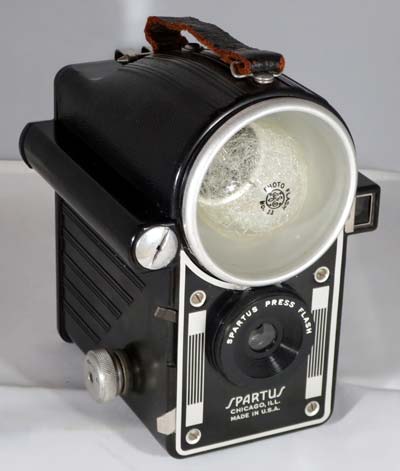Spartus Press Flash
Specification

| Manufacturer | : | Spartus |
|---|---|---|
| Produced | : | 1939 |
| Classification | : | Medium Format |
| Body Type | : | Box |
| Construction | : | Bakelite |
| Film Type | : | 120 |
| Film Width | : | 62mm |
| Image Size | : | 2¼ x 3¼ in |
| No. of Images | : | 8 |
| Lens Type | : | meniscus |
| Focal Length | : | 120mm |
| Focus Type | : | Fixed |
| Focal Range | : | 6 ft - inf. |
| Aperture Type | : | Multihole |
| Apertures | : | f/16, f/22 |
| Shutter Type | : | Rotary |
| Shutter Speeds | : | T, I*(1/70s) |
| Size (w x h x d) | : | 110 x 165 x 132 mm |
| Weight | : | 715g |
| * Measured on this camera | ||
Art Deco Credentials
![]()
![]()
![]()
![]()
Significant: Pronounced and self evident
I consider this camera to warrant 4 stars for the following attributes:
- produced during the main Art Deco period
- silver geometric pattern on black faceplate
- Art Deco lettering on faceplate
- moulded Bakelite body
- geometric multiline ribbed mouldings in Bakelite
- chrome embellishments
- decorative knurled and coned latch on back
- symmetrical layout to front
Description
The Spartus Press Flash was one of a series of cameras having much the same design. First appearing as the Falcon Press Flash by the Utility Manufacturing Company in New York, this was the first camera with built-in flash reflector. The name changed to Spartus with the Chicago company's acquisition of Utility. It uses old-style Edison screw-base(E27) flash bulbs which are inserted whilst pressing the bulb release button under the strap. They are not screwed in. It will take GE #11 bulbs or Sylvania Press #40 which are equivalent. It takes two AA batteries in a tubular battery bay opposite the viewfinder. Unfortunately the rear battery contact connects to the side of the battery. This means that many modern batteries do not work and you need to remove any paper covering of appropriate batteries so that contact can be made. Even then, the produding pin in the battery bay stops some batteries from being inserted.
It uses 120 film rolls for 8 exposures of 2¼ x 3¼ in. It had two aperture settings, one for "bright" light(f/22) and one for "cloudy & flash" (f/16) situations. The aperture setting is achieved by using a slide out tab below the shutter release. It has a single reverse galilean viewfinder on the side. It does not have a tripod mount.
The same design was marketed from 1939 to 1950 under several names with only the front plate changed. These included the Regal Flash Master, the Falcon Press Flash and the Galter Press Flash.
How to Use
The User Manual for this camera is found here:- http://www.cameramanuals.org/pdf_files/spartus_press_flash.pdf
This camera takes 120 film which is widely available. It is advisable to cover the red window except when winding film in low light.
The aperture choice is f/16 or f/22. The measured speed on this camera was 1/70s. As the shutter speed is only 1/70s, it is advisable to hold it against a wall or other solid object to get shake-free images. For quick snapshots, hold it firmly against your body.
The table shows how this camera will perform using ISO 100 film. It is based on the 'Sunny 16' rule. Modern film is so forgiving and will produce acceptable results even when overexposed by 2 or 3 stops or underexposed by 1 stop.
The tables assume that the sun is at least 30 degrees above the horizon - that's 10am - 5pm on a summers day (May-August) in the UK.
Remember that the exposure guide in the manual may not be helpful as it is based on the use of old film with a low ISO value.
Using ISO 100/125 film - shutter speed 1/70s
| Weather Conditions | Shadow Detail | Aperture | Exposure |
|---|---|---|---|
 Sunny SunnySnow/Sand | Dark with sharp edges | f/22 | +1 Stop Overexposed Acceptable |
 Sunny Sunny | Distinct | f/22 | Good |
 Slight Overcast Slight Overcast | Soft around edges | f/16 | Good |
 Overcast Overcast | Barely visible | f/16 | -1 Stop Underexposed Acceptable |
 Heavy Overcast Heavy Overcast | None | f/16 | -2 Stops Underexposed Not Acceptable |
 Open Shade Open Shade/Sunset | None | f/16 | -3 Stops Underexposed Not Acceptable |